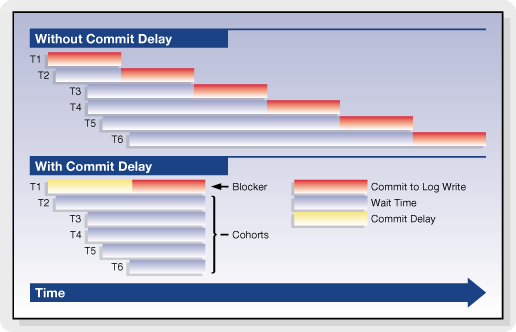Without commit delay, each thread performs its own transaction log flush during a transaction commit. When commit delay is enabled, rather than each thread directly flushing the transaction log during a commit, threads enter the commit delay logic which behaves as follows.
In previous versions, any thread executing in the commit delay logic is known as either the blocker or a cohort. The blocker is the thread that eventually performs the transaction log flush on behalf of all threads waiting in the commit delay logic. A thread becomes the blocker on entry to the commit delay logic if there is not already a thread designated as the blocker. The blocker acquires a synchronization object (blocker), which is used to coordinate the threads (cohorts) that subsequently enter the commit delay logic. The blocker sleeps for the commit delay period specified in the server configuration file, wakes up, flushes the transaction log, and clears the block.
While the blocker is sleeping, other threads may enter the commit delay logic during their own transaction commit operations. These threads are known as the cohorts. The cohorts wait for the blocker to clear the block. When the blocker clears the block, each cohort acquires and releases the block, exits the commit delay logic without flushing the transaction log (because the blocker has already done this), and completes its commit operation.
Effect of commit delay on transaction commit times for multiple threads

The above figure shows the effect of commit delay on the commit times for individual threads. The left side of the figure shows the situation when commit delay is disabled. The right side shows the situation when commit delay is enabled. This example shows six threads (labeled T1 through T6) with random arrival times in the transaction commit log flush logic. In this example, the thread T1 arrives first, followed by thread T2 and so on through thread T6.
When commit delay is disabled, each thread flushes the transaction log in turn. The shaded part of the rectangles represents the time spent by each thread flushing the transaction log. Thread T1 flushes first. T2 waits until T1's flush completes and then performs its flush, and so on.
When commit delay is enabled, the first thread entering the commit delay logic becomes the blocker (thread T1 in this example). Threads entering the commit delay logic after this point in time (threads T2 through T6) become cohorts. The blocker sleeps for the commit delay period and then flushes the transaction log. The cohorts sleep until the blocker has finished flushing the transaction log and has released the block, at which point they acquire and release the block and complete their commit without flushing the transaction log.
An exception to the “blocker - cohort” concept arises when the log buffer becomes full prior to the delay period. In this instance, the cohort will flush thus releasing the blocker. Statistics are captured to measure this occurrence and to assess how the transactions flow through the commit delay logic.